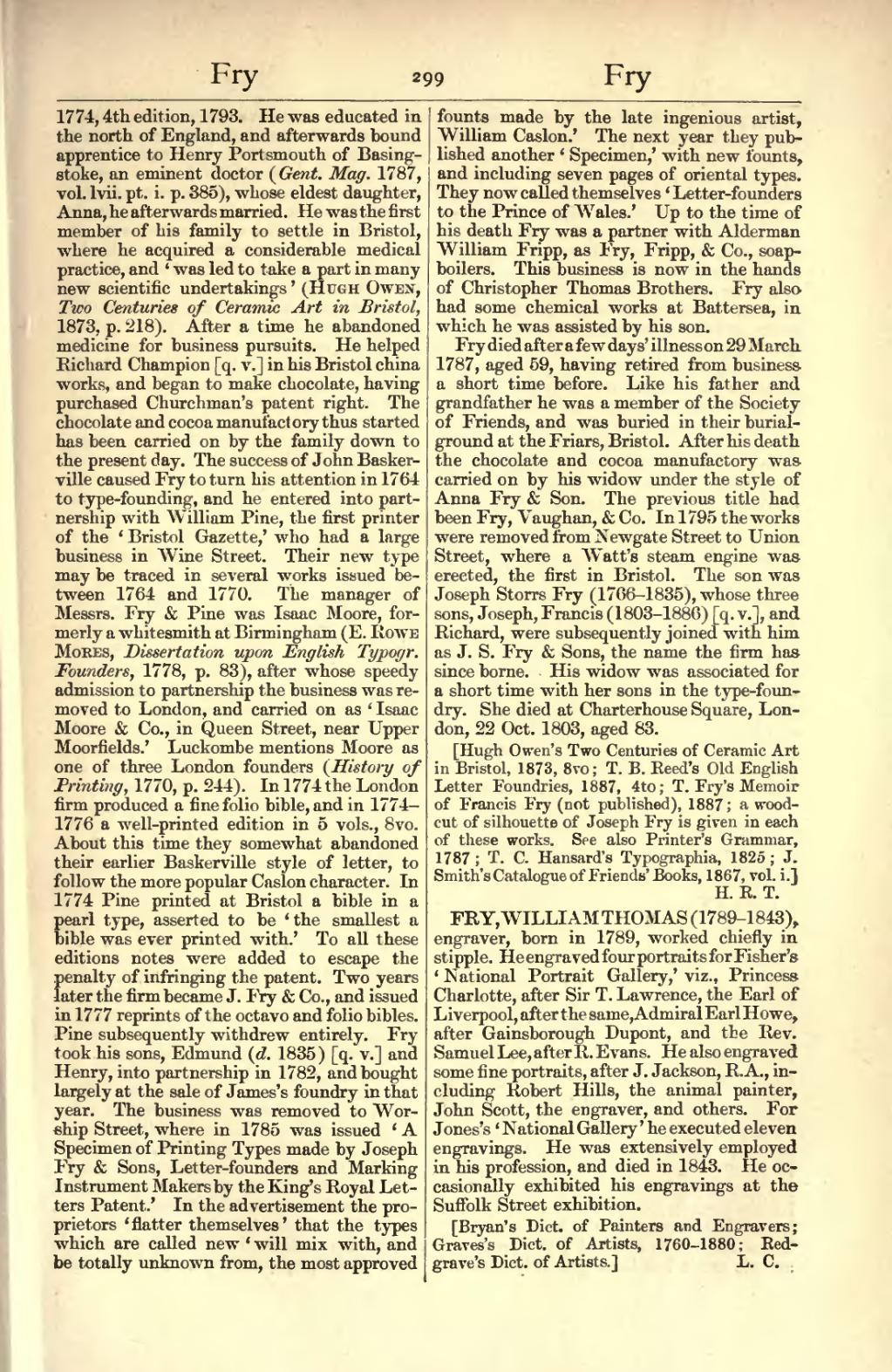1774, 4th edition, 1793. He was educated in the north of England, and afterwards bound apprentice to Henry Portsmouth of Basingstoke, an eminent doctor (Gent. Mag. 1787, vol. lvii. pt. i. p. 385), whose eldest daughter, Anna, he afterwards married. He was the first member of his family to settle in Bristol, where he acquired a considerable medical practice, and ‘was led to take a part in many new scientific undertakings’ (Hugh Owen, Two Centuries of Ceramic Art in Bristol, 1873, p. 218). After a time he abandoned medicine for business pursuits. He helped Richard Champion [q. v.] in his Bristol china works, and began to make chocolate, having purchased Churchman's patent right. The chocolate and cocoa manufactory thus started has been carried on by the family down to the present day. The success of John Baskerville caused Fry to turn his attention in 1764 to type-founding, and he entered into partnership with William Pine, the first printer of the ‘Bristol Gazette,’ who had a large business in Wine Street. Their new type may be traced in several works issued between 1764 and 1770. The manager of Messrs. Fry & Pine was Isaac Moore, formerly a whitesmith at Birmingham (E. Rowe Mores, Dissertation upon English Typogr. Founders, 1778, p. 83), after whose speedy admission to partnership the business was removed to London, and carried on as ‘Isaac Moore & Co., in Queen Street, near Upper Moorfields.’ Luckombe mentions Moore as one of three London founders (History of Printing, 1770, p. 244). In 1774 the London firm produced a fine folio bible, and in 1774–1776 a well-printed edition in 5 vols., 8vo. About this time they somewhat abandoned their earlier Baskerville style of letter, to follow the more popular Caslon character. In 1774 Pine printed at Bristol a bible in a pearl type, asserted to be ‘the smallest a bible was ever printed with.’ To all these editions notes were added to escape the penalty of infringing the patent. Two years later the firm became J. Fry & Co., and issued in 1777 reprints of the octavo and folio bibles. Pine subsequently withdrew entirely. Fry took his sons, Edmund (d. 1835) [q. v.] and Henry, into partnership in 1782, and bought largely at the sale of James's foundry in that year. The business was removed to Worship Street, where in 1785 was issued ‘A Specimen of Printing Types made by Joseph Fry & Sons, Letter-founders and Marking Instrument Makers by the King's Royal Letters Patent.’ In the advertisement the proprietors ‘flatter themselves’ that the types which are called new ‘will mix with, and be totally unknown from, the most approved founts made by the late ingenious artist, William Caslon.’ The next year they published another ‘Specimen,’ with new founts, and including seven pages of oriental types. They now called themselves ‘Letter-founders to the Prince of Wales.’ Up to the time of his death Fry was a partner with Alderman William Fripp, as Fry, Fripp, & Co., soap-boilers. This business is now in the hands of Christopher Thomas Brothers. Fry also had some chemical works at Battersea, in which he was assisted by his son.
Fry died after a few days' illness on 29 March 1787, aged 59, having retired from business a short time before. Like his father and grandfather he was a member of the Society of Friends, and was buried in their burial-ground at the Friars, Bristol. After his death the chocolate and cocoa manufactory was carried on by his widow under the style of Anna Fry & Son. The previous title had been Fry, Vaughan, & Co. In 1795 the works were removed from Newgate Street to Union Street, where a Watt's steam engine was erected, the first in Bristol. The son was Joseph Storrs Fry (1766–1835), whose three sons, Joseph, Francis (1803–1886) [q. v.], and Richard, were subsequently joined with him as J. S. Fry & Sons, the name the firm has since borne. His widow was associated for a short time with her sons in the type-foundry. She died at Charterhouse Square, London, 22 Oct. 1803, aged 83.
[Hugh Owen's Two Centuries of Ceramic Art in Bristol, 1873, 8vo; T. B. Reed's Old English Letter Foundries, 1887, 4to; T. Fry's Memoir of Francis Fry (not published), 1887; a woodcut of silhouette of Joseph Fry is given in each of these works. See also Printer's Grammar, 1787; T. C. Hansard's Typographia, 1825; J. Smith's Catalogue of Friends' Books, 1867, vol. i.]
FRY, WILLIAM THOMAS (1789–1843), engraver, born in 1789, worked chiefly in stipple. He engraved four portraits for Fisher's ‘National Portrait Gallery,’ viz., Princess Charlotte, after Sir T. Lawrence, the Earl of Liverpool, after the same, Admiral Earl Howe, after Gainsborough Dupont, and the Rev. Samuel Lee, after R. Evans. He also engraved some fine portraits, after J. Jackson, R.A., including Robert Hills, the animal painter, John Scott, the engraver, and others. For Jones's ‘National Gallery’ he executed eleven engravings. He was extensively employed in his profession, and died in 1843. He occasionally exhibited his engravings at the Suffolk Street exhibition.
[Bryan's Dict. of Painters and Engravers; Graves's Dict. of Artists, 1760–1880; Redgrave's Dict. of Artists.]
